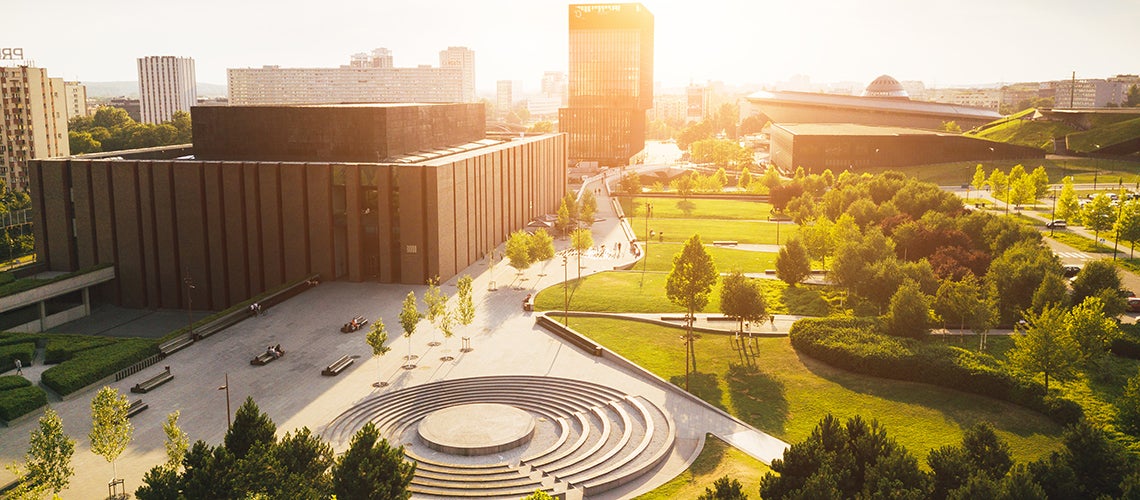 Photo credit: Adobestock
Photo credit: Adobestock
Today, 4.4 billion people— just over half the world’s population—live in cities. In just the next three decades, two out of every three people on the planet will live in cities. Cities are the drivers of productivity and prosperity: over 80 percent of all economic activity is concentrated in them. But they are also on the frontlines of multiple crises – feeling the impacts of COVID-19, of conflict and fleeing populations, and of climate change - that can exacerbate risks and widen inequalities.
Tackling these challenges and better managing urbanization – and its positive and negative impacts – will be at the heart of conversations by representatives of national and local governments, urban planners, international organizations, civil society groups, youth, and industry experts are meeting at the World Urban Forum in Poland this month.
The context of these challenges will no doubt be top of mind. The COVID-19 pandemic, for instance, created a unique economic burden for cities: spending more on social protection while simultaneously losing local revenue sources due to lockdowns that dramatically affected city centers and reduced economic activity – formal and otherwise. Many of these financial risks remain high because of an uneven recovery and the uncomfortable reminder that the pandemic is not quite yet in the rearview mirror.
Consider also forced displacements arising due to conflict. This years’ World Urban Forum, taking place in Katowice, is just about 500 miles from the Ukraine border from where over 6.5 million civilians have fled in the last few months. People fleeing conflict and moving to cities are, in fact, on the rise globally: by June of 2022, there were over 100 million people forcibly displaced around the world, out of which 48 million internally displaced persons (IDPs), 26.6 million refugees and 4.4 million asylum seekers, with more than half of IDPs and refugees living in urban areas.
Finally, consider climate change. 70 percent of cities have had to deal with the adverse impacts of climate change on their citizens and infrastructure with implications for lives, livelihoods and national budgets. In the 136 biggest coastal cities, 100 million people are exposed to coastal floods, often imposing a burden on daily expenses for those who can afford it the least. Cities are also a growing source of greenhouse gas emissions, consuming two-thirds of global energy and accounting for more than 70 percent of GHG emissions. Ensuring that the urban transformation proceeds in a sustainable way requires concrete steps and actions at both national and local levels and stronger multilateral partnerships.
Each crisis on its own already jeopardizes cities and their potential to drive economic growth. Taken together, their impact can be devastating and long-lived. Cities require real, tangible, and actionable goals—and leaders who can drive them forward—to respond to these crises and become safe, inclusive, and resilient spaces for billions around the world.
Moving cities into the position to become their own solutions involves first healing wounded economies and preparing now for mitigating future climate change and its impacts. Here are three elements that underpin our approach to supporting cities to recover, respond, revitalize their economies while preparing for an increasingly uncertain future:
First: ensure that all citizens benefit from the pandemic recovery: COVID-19 has laid bare existing stark inequalities within cities with vulnerable groups, low-income groups, racial and ethnic minorities, and informal workers being unequally affected by the virus and the knock-on effects of it. To ensure an inclusive recovery will mean that cities will need to plan and invest in ways that improve access to housing, jobs, and health and other services for all in their societies. In Freetown, Sierra Leone, for instance, investments in boosting urban tree cover also helped created around 500 short-term jobs during the pandemic: a double win of boosting urban resilience and generating livelihoods.
Second: invest in well-planned urban development to help avoid future emissions and climate risk. Urban infrastructure and mobility networks built today, to boost the economic recovery from the pandemic, could set in place patterns of growth, consumption, emissions, and vulnerabilities for generations. Action in cities today towards well-planned, compact urban development should be green, resilient and inclusive, making cities more efficient and well connected with better access to services. Investments such as establishing circular economies, ensuring adequate water and sanitation services, and improving low-carbon transit options will reap significant dividends for urban residents.
This is the case for Türkiye, where about 30 cities have been working to improve access to quality, sustainable and resilient public transport, water, energy efficiency, and urban environments. Better planning urban investments helps increase national preparedness and capacity to avoid and adapt to the adverse effects of climate change.
Finally: invest in a ‘people-in-place’ approach to manage the implications of conflict and forced displacement in urban settings: This means accounting for considerations across two dimensions: first, the vulnerabilities of people being displaced, and second, the needs of the place where they are located. As more people access limited services, this places an extra layer of stress on an already fragile system. Interventions, therefore, need to shift from humanitarian assistance to one that integrates displaced people into the urban fabric in a sustainable manner. Our recent experiences supporting a multisectoral approach for comprehensive urban solutions for both the displaced and host communities in Lebanon, for instance, focused on increasing the capacities of local governments and reducing social tensions including by involving communities themselves in the process.
There’s no question the pandemic has left many countries, especially developing ones, with weakened financial capacity; cities too. Therefore, tackling the compounding crises with adequate financing will require governments to play a more active role and for local levels of government to work closely with them to ensure these finances are directed in transforming cities sustainably taking into account their specific needs and challenges. This requires making informed investments with limited public resources; mobilizing private capital at scale; and making good use of resources from international financial institutions and multilateral development banks, especially to help rebuild the financial capacity of cities which may have reversed during the pandemic.
The World Bank is ramping up its technical expertise and applying a variety of financial mechanisms to support cities, whether helping invest in preparedness, respond in the face of a disaster, or build cities of the future where people can move, breathe, and be productive, delivering on average of $6-7 billion each year. Creating these healthy, resilient, and vibrant cities takes time and investment, but the benefits are too high to ignore.
This piece was originally published in Polish by PORTAL SAMORZADOWY on June 24, 2022.


Join the Conversation